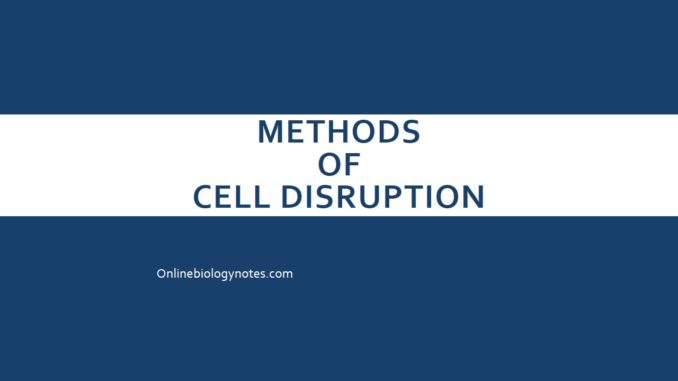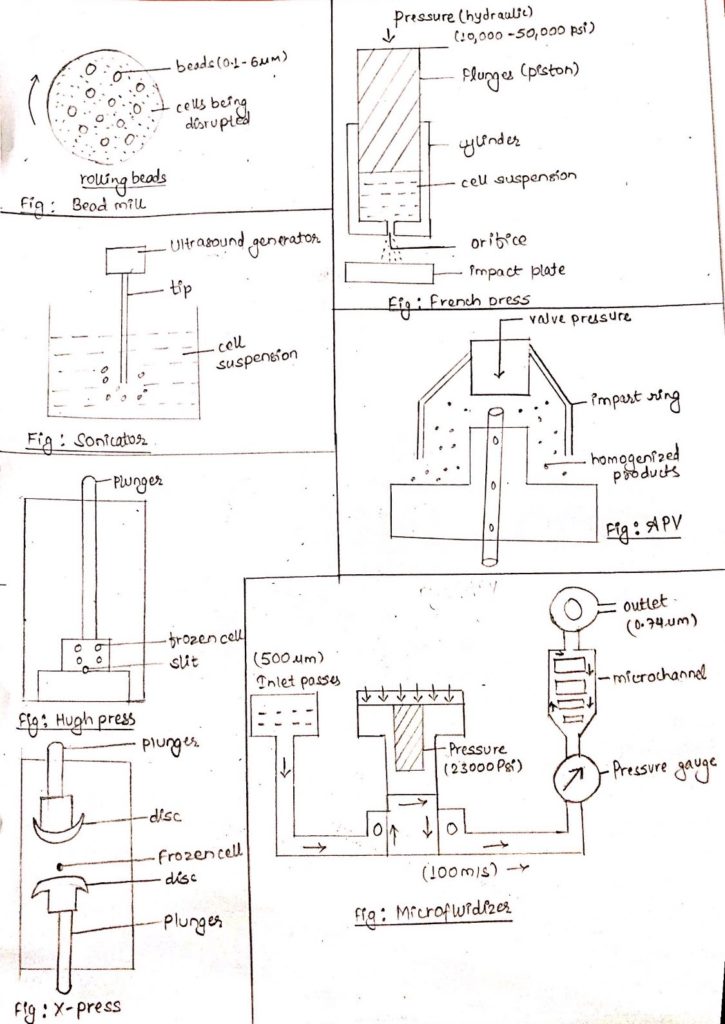
Cell disruption:
- The process of breaking apart of the cells in order to obtain the desired product which may be intracellular or periplasmic is called cell disruption.
- There are various methods for cell disruption but before employing any method, following factors should be considered before selecting any method.
- Size of cell sample
- Toughness of the cell is whether it is bacteria, fungi, plant cell or animal cells.
- Efficiency of disruption method
- Stability of the product to the method employed.
- Easy extraction and purification
- Whether the cell is biohazardous or not
- Cost and time
- Expertise or training required or not.
Methods of cell disruption
Physical methods of cell disruption:
- Mechanical method:
- Bead will
- Homogenizer
- Microfluidizer
- Sonicator
- French press/ X-mesh
- Non-mechanical method:
- Decompression
- Osmotic shock
- Thermolysis
- Freeze thaw
- Dessication
- Cell bomb
These Mechanical methods are used to break tough cells.
i. Bead mill:
- The bead will consist of tubular vessel made up of metal or glass within which small beads are kept.
- When vessel rotates, the beads also starts rotating but away from axis.
- The shear force and impact of beads causes disruption of cells.
- Advantages:
- It is very useful for small sized materials and it doesn’t release harmful aerosols.
- Bead mill can be carried out in both batch and continuous fashion.
- Commonly used for disruption of yeast cells and for grinding animal tissues.
- Disadvantages:
- It produces large amount of heat so thermolabile materials cannot be disrupted.
ii. French press:
- French press consists of a cylinder with orifice at bottom.
- The piston is pressed with hydraulic pressure so that cell suspension exists through small orifice and strike on impact place.
- The impact causes cell disruption.
- It is commonly used for small scale recovery of intracellular materials from bacterial and plant cell.
iii. Sonicator:
- About 50Khz frequency is applied on cell suspension which causes the formation of tiny bubbles within liquid.
- It is very fast method.
- It breaks cells in 30-60 second and yeast cell (2-3mins).
- Disadvantages:
- Heat generation
- Noise pollution
- Expensive process
- Generate free radicals that might interfere desired product.
iv. Homogenizer:
- Different types of tissue homogenizer are used:
- Pressurized homogenizer
- High pressure homogenizer e.g. APV
v. Ultra sonicator
- APV is high pressure homogenizer used in large scale.
- The pressure is applied through valve pressure, when pressure inside the vessel reaches the atm pressure, cell bursts in this process, no heat is generated because inert gases are used in the vessels.
- This is a gentle technique used for animal cells disruption but not for plant cells and fungi.
vi. Microfluidizer:
- In this method pressure is applied that causes production of small sized particles.
- This method is applied to lab scale.
- Pressure and shear force cause disruption of cell.
- Disadvantages:
- Expensive method
- Cannot used for large scale production

II. Non-mechanical methods :
i. Decompression:
- In this method, large amount of N2 gas is used to dissolve cell and high pressure (25000 Psi) is applied when gas pressure is suddenly released, N2 gas comes out of cell forming gas bubbles and burst causing disruption of cell.
- Advantages:
- No heat generation
- This method protects enzymes and cell organelles.
- Disadvantages:
- Cannot be used for yeast and plant cells.
ii. Osmotic shock:
- In this method, either hypotonic or hypertonic solution is used.
- The cell suspension is placed on either of the solution which create osmotic shock.
- Hypotonic solution:
- Plasmolysis occur, the water enters the cytoplasm of cell and well burst.
- Hypertonic solution
- Plasmolysis occur, the cell shrinks due to loss of water from cell.
- This is not always effective so it is used in combination with other process.
iii. Thermolysis (Heat shock protein):
- This method is very easy and economical for heat stable product.
- High heat inactivates cell by disrupting cell wall and release intracellular products.
- The effect of heat depends upon various factors such as pH, temperature, chelating agent, ionic strength, presence of enzymes (proteolytic and hydrolytic), time etc.
- Disadvantage:
- Cannot be used for heat labile substances
- Spore forming bacteria are also resistant to this method.
iv. Freeze-thaw:
- This is commonly used method to disrupt animal and bacterial cell.
- In this method, the cell suspension is frozen in dry ice an ethanol or freezer and then thaw the suspension at room temperature (37oC).
- This suddenly freezing and thawing causes the cells to swell and break.
- The process is repeated for several time for efficient lysis.
- Disadvantages:
- Very slow process
- Not always effective
iv. Dessication:
- In this method, the cell suspension is dried by air drying or vacuum drying.
- After dessication, the cell shrinks.
- If excess water is provided than cell burst.
- This process is repeated for several time.
- Disadvantages:
- Slower process and require several repeats.
- Always used in combination with other process.
v. Electric lysis (Electroporation):
- When cell suspension is placed in electric field with intensity higher than certain threshold, there is formation of nano scale pore on cell surface.
- This pore maybe reversible or irreversible, depending upon applied field and direction of field.
- Through the pores, the intracellular material releases out.
- Disadvantages:
- Heat generation
- Expensive process
Chemical methods of cell disruption:
- Chemical permeabilizer
- Antibiotics
- Detergents
- Chartrops
- Chelating agents
- Hydroxides and hypochlorides
i. Chemical permeabilizer:
- Chemicals such as Toluene, ether, phenylethylalcohol, benzene, methanol, chloroform etc. form a channel in cell membrane.
- These are lipid solubilizer, forming pore through which cellular content releases out.
ii. Antibiotics:
- Polymyxin, azoles, Nystatin are cell membrane inhibitor and destroy cell membrane inhibitor and destroy cell membrane formation causing release of cellular content.
iii. Detergents:
- They are also called as surfactant.
- They solubilize lipid and denature protein.
- There are three types of detergents:
- Anionic – e.g. SDS
- Cationic
- Non-ionic- tween-20, tritan X-100, tritan X-400 etc.
- The non-ionic detergents are commonly used in cell disruption.
- The process is very fast.
- Disadvantages:
- Disruption might be incomplete.
- Repetition may be required.
iv. Chelating agent:
- EDTA is good example of chelating agent.
- It chelates cations (bivalent) and make unavailable for cell causing disruption of cell membrane. (Mg2+, Ca2+)
v. Chaotropic agent:
- Urea, Guanidine chloride etc. are chaotropic agent.
- They disrupt the structure of protein and nucleic acids and decrease hydrophobic interaction among the surrounding molecules by disordering water molecules adjacent to protein molecule.
- Therefore, membrane constituent become disformed and cell lyse.
vi. Peroxide and hypochloride:
- HClO and H2O2 oxidizes the cellular structure.
- HClO damages the lipid bilayer and inhibit -SH group of protein.
- The oxidization of cell membrane lyses the cell to release cellular constituents.
Biological methods or enzymatic methods of cell disruption
- Autolysis
- Lytic enzyme
- Phage lysis
i. Autolysis:
- Cell membrane acting chemicals such as Toluene, antibiotics etc. activates lytic enzyme of the cell.
- The lytic enzyme causes self lysis of cell.
- The chance of contamination of product is less.
ii. lytic enzyme
- Different enzymes such as lysozyme, cellulase, zymogenase, proteases, etc. are used to lyse the wells.
- This method is used in small scale.
iii. Phage mediated lysis:
- T4-phage, OX174, ssRNA phage, etc. are bacteriophage.
- They penetrate and multiply inside bacterial cell and then causes lysis of cell by producing endolysin and murein hydrolase enzymes,
